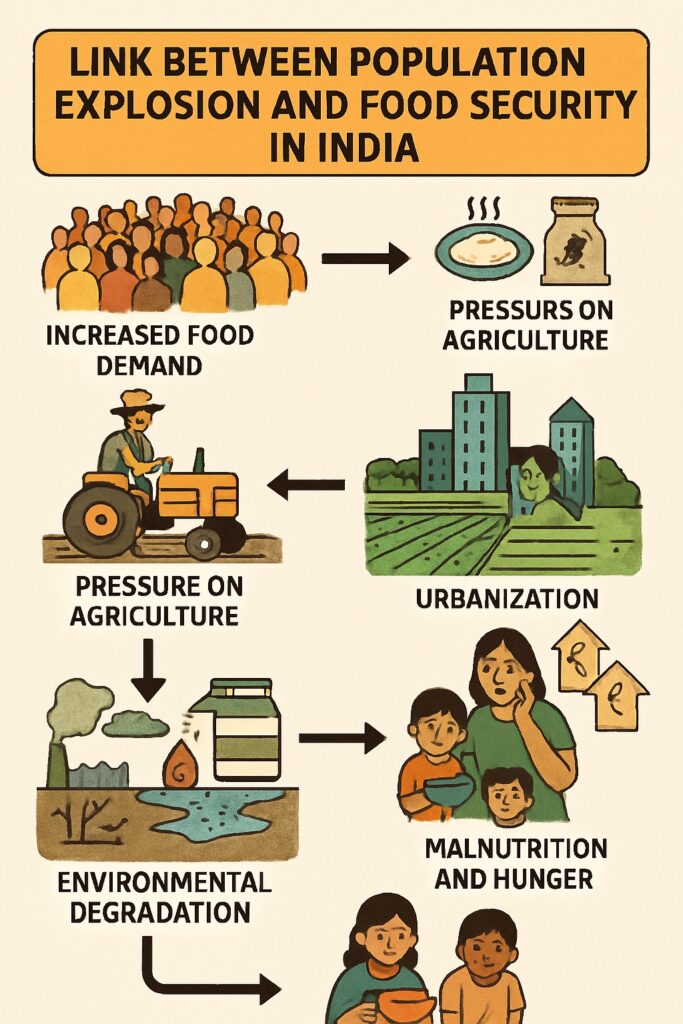Population explosion refers to the rapid and unchecked growth of the human population, while food security means ensuring that all people have physical, social, and economic access to sufficient, safe, and nutritious food. In India, the growing population poses a serious challenge to achieving food security. With over 1.4 billion people, India must balance population growth with agricultural productivity, distribution, and sustainability to feed its citizens adequately.

Table of Contents
What is Population Explosion?
Population explosion occurs when the birth rate exceeds the death rate over a sustained period, leading to a sudden and steep increase in population. In India, this rapid rise has been due to:
- Decline in mortality due to better healthcare
- High birth rate, especially in rural areas
- Lack of awareness and access to family planning
What is Food Security?
According to the FAO (Food and Agriculture Organization), food security exists when “all people, at all times, have physical and economic access to sufficient, safe and nutritious food”. It has four key dimensions:
- Availability – Enough food production
- Access – Economic and physical access to food
- Utilization – Nutritional value and safe consumption
- Stability – Consistent availability over time
Link Between Population Explosion and Food Security
- Increased Food Demand: A growing population demands more food, putting stress on land, water, and other resources.
- Pressure on Agriculture: Limited land and outdated farming techniques lead to lower productivity.
- Urbanization: Expanding cities reduce arable land.
- Food Price Inflation: Increased demand can drive up food prices, making it unaffordable for poor families.
- Malnutrition and Hunger: Overpopulation often leads to unequal food distribution and undernourishment.
- Environmental Degradation: Overuse of fertilizers, pesticides, and water resources affects long-term agricultural sustainability.
Current Situation in India
- India produces large quantities of food (grains, pulses, vegetables), but still ranks high in global hunger indices.
- Over 189.2 million people in India are undernourished (as per Global Hunger Index 2023).
- Despite government schemes, poverty, poor infrastructure, and climate change make food security a continuing challenge.
Government Efforts to Ensure Food Security
- Public Distribution System (PDS):
- Supplies subsidized food grains to over 80 crore people under the National Food Security Act (NFSA).
- Mid-Day Meal Scheme:
- Provides free meals to schoolchildren to improve nutrition and attendance.
- Integrated Child Development Services (ICDS):
- Targets nutrition for mothers and young children.
- Promotion of Sustainable Farming:
- Use of organic farming, soil health cards, crop insurance (PMFBY).
- Digital Agriculture and Storage Improvements:
- Reduces wastage and ensures better food supply chains.
Solutions to Balance Population and Food Security
- Population Control Measures:
- Promote family planning, reproductive health, and education (especially for women).
- Encourage the two-child policy through awareness and incentives.
- Increase Agricultural Productivity:
- Use of modern technology, high-yield seeds, and smart irrigation.
- Encourage crop diversification and reduce dependence on rice and wheat.
- Reduce Food Wastage:
- Improve cold storage and transportation facilities.
- Raise public awareness on food conservation.
- Focus on Nutrition, Not Just Quantity:
- Promote cultivation of pulses, millets, and vegetables to improve nutrition.
- Climate-Resilient Agriculture:
- Encourage drought-tolerant and flood-resistant crop varieties.
Conclusion
India’s population explosion has a direct impact on its food security. If not managed, it can lead to widespread hunger, malnutrition, and poverty. However, with the right policies, technological innovation, public participation, and a focus on sustainable development, India can ensure that its growing population is fed, healthy, and secure. A balance between population control and agricultural reform is the key to a food-secure future.
Read: Geography Notes